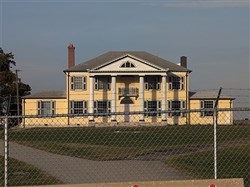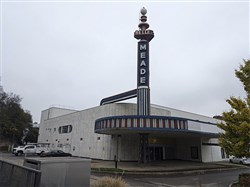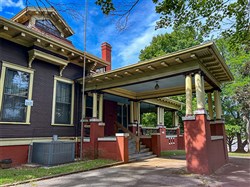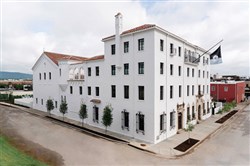VOL. 48 | NO. 47 | Friday, November 22, 2024
Helping history find a future
By Joe Morris
One person’s ugly brick building is another’s portal to history. That empty lot? Sure, maybe something happened there 50 years ago, but now it could hold a condo complex or three.
These are some of the conversations as Tennessee cities tackle an increasingly dire housing shortage. Denser infill is seen as a way to help solve the problem because in-town, bigger lots, sometimes empty or with only one dwelling or structure, are natural targets.
These older buildings, be they houses, schools, churches or whatever, are often seen as land hogs whose acreage could be put to better use. At least that’s how some see the issue.
Others, whose leanings are more toward preservation, see endangered structures that, once gone, will take with them a big part of the neighborhood and larger community’s story.
In the past, battle lines have been drawn early: A developer buys a property, then announces a new use for the site. Opposing forces marshal their troops and begin lobbying the community, local officials and whoever else will listen about the importance of what’s sitting on that land now, or that parcel’s history, and why it should be saved.
Sometimes the preservationist side scored a win, sometimes the developer did. More increasingly in recent years, they met in the middle.
In many instances there’s less of a focus on winning and losing, and more on a way to find ways for everyone to come away from land and property reuse with at least some of what they want. A big part of what’s driving that change is how preservation organizations are helping property owners and developers uncover tax credits and other financial incentives to adaptively reuse versus demolish.
There’s also been a movement toward heritage tourism, so that venerable structures can do more than generate property tax. The result, preservation organizations say, is some major wins that can lead by example and help communities meet their housing crunch in novel ways.
Knoxville highlights architectural heritage
The 2024 Fragile & Fading list was unveiled by Knox Heritage, a nonprofit focused on preserving, restoring and transforming historically significant structures and places, in August.
Once again it called to attention structures that are at risk due to everything from shifting property values and needs to structural problems.
Over time, the list’s reason for being has expanded beyond preservation to also highlight resource conservation and a property’s potential visitor appeal, says Christine Cloninger, executive director.

The Colemere Manor was built in 1893, was most recently a Monell's location and is now owned by the Metro Nashville Airport Authority.
-- Photograph Provided“Fragile & Fading was introduced decades ago as an advocacy tool, something that called attention to the city’s most endangered places,” Cloninger says. “The goal was to galvanize the community and inspire collaborative preservation efforts. We believe that community involvement is crucial for preservation, so this would give residents, businesses and local leaders a starting point to collaborate and save these places.”
Sometimes that meant saving a building from demolition, or a renovation that would forestall its ability to teach its own history. Other times, it meant saving a piece of land that had housed a building, or event, worthy of continued recollection.
Conversations, when they were even held, could be difficult and short because preservationists were seen as wanting to freeze everything and not allow for a single change. Developers were seen as rapacious pursuers of profit at the expense of history. Some reeducation, on both sides, was in order.
“It wasn’t always confrontational, but it could be,” Cloninger says. “It’s the property owners’ right to do what they want with their property. The local and state laws are usually on their side in that regard. What I’ve learned in my time at Knox Heritage is that preservationists are not looking to seal communities in amber, keeping them as-is forever and ever.
“It’s more about how we can preserve these historic places and spaces to meet the needs of the community today. But it’s also very important to us to support what the owner or developer wants to do.”
Enter affordable housing, the closer to the urban core the better. Depending on zoning that can mean knocking down a large structure such as an old, shuttered church or school and then building multiple houses, apartments or condos on the land.
That can be the fastest way to profitability for the owner and/or developer – but sometimes there are other options, and they have some financial incentives (see sidebar) that provide significant appeal.
“We work with a lot of owners and other stakeholders to show them how preservation and progress can go hand in hand,” Cloninger says. “Historic preservation doesn’t have to be a barrier to affordable housing; in fact, sometimes it can be part of the solution.”

The Belle Meade Theater made Historic Nashville Inc.’s Nashville Nine endangered list this year.
-- Photograph ProvidedShe points out the use of large vacant or underutilized buildings as a prime example of adaptive reuse. Case in point? The Giffin School, which has been on the Fragile and Fading list for many years.
After cycling through a couple of owners and being named to the National Register of Historic Places, it now is being restored and converted to condominiums, with additional workforce housing being built on-site. To make that happen, a lot of conversations took place – and the existence of historic tax credits didn’t hurt.
“We worked with the developer to apply and receive those,” Cloninger says. “A big part of what we do is make sure people know about whatever subsidies and incentives exist for site preservation. People think teardown is the easiest solution, and that is not always the best way to leverage that property. That’s where we usually come in.”
Knoxville has had those tools available to varying degrees for several years, through city grant programs (see sidebar). There is no historic property tax credit at the state level, but there are some federal ones. Tennessee does offer some grant funding for renovating historic structures. It comes down to a redevelopment, or reuse, that fits into some guidelines around what the site or building was, and what will be its new purpose.
Knox Heritage is well versed in getting those various applications across the finish line, as evidenced by multiple adaptive reuses in the downtown area over the years that helped create a thriving residential community and reinvigorated retail corridors along Gay Street and in Market Square.
“We’re not coming after anyone with pitchforks and torches,” Cloninger says. “We’ve been called ‘hysterical preservationists’ before, but we’re just people who care about where we live, and care about that connection to our shared history. Often people find out about a building in their neighborhood through the Fragile and Fading list, a place they’ve driven by every day and never really paid attention to.
“They get interested in that building and how they’ll be affected by proposed changes to it,” she continues. “We serve as the connector between the property owners and developers, the surrounding community and the site itself. Our goal is to let that site continue to serve its purpose and create a better result for everyone involved.”
Chattanooga’s past wins and losses inform current efforts

Knox Heritage first placed the Howard House on its Fragile & Fading list in 2015. But renovation plans have stalled, and long-term use of the site is unclear.
-- Photograph ProvidedEducation and awareness also are tentpole goals at Preserve Chattanooga as well, says Todd Morgan, executive director.
“Our mission is to protect the heritage of Chattanooga and Hamilton County, and we do that in many ways,” Morgan says. “Sometimes that’s responding to an individual property owner who needs assistance with preservation-related questions or issues. In other cases, that’s helping to create a preservation easement to protect some key buildings like the Dome Building, Customs House and the Chattanooga Choo-Choo’s terminal building. We’ve even partnered with the University of Tennessee-Chattanooga to introduce a historic preservation minor where we provide adjunct professors.”
Like his Knoxville counterparts, Morgan can point to large-scale successes in the form of former schools and retail properties that have become senior-living projects or other types of residential hub such as condos or lofts.
In many of those cases, federal tax credits that can rise as high as 20% for projects that will serve as rental units for a set number of years before converting to owned units such as condos, have sealed the deal.
“Those credits sometimes can be sold off or syndicated, which means a capital infusion up front for a project,” he explains. “There are also some grants, such as one the state offers for commercial historic buildings. Even if your city doesn’t offer a local grant, sometimes you can negotiate lower-interest loans or other kinds of assistance to encourage investment in a neighborhood that needs it.”
Achieving housing density and protecting neighborhood character can be elusive but Morgan says once people see it done, they realize it’s worth the effort.
“People become interested in preservation when they see older homes give way to cookie-cutter, ‘tall and skinnies’ along their streets,” Morgan says. Even so, not every structure can be saved, no matter how strong the interest. That makes the wins like the Ellis Hotel, which was donated to Preserve Chattanooga by the city, stabilized and eventually became home to a popular restaurant, all the sweeter.

Common House Chattanooga, originally built in 1929 as a YMCA, was restored in 2021.
“It’s hard to put a dollar figure on it, but when the historic Park Place School became condominiums, the people who actually went to school there were very happy,” Morgan says. “They are very nostalgic about that building, and many were the first in line for a unit so they could live there. It’s all about memories and connections. And when the developers do something like integrate a little museum into the space so visitors can see what it used to be, it further preserves its unique identity and history.”
That’s why the losses sting, even though local preservationists know that sometimes a place is too far gone to save.
“We have invested in buildings, like helping fund a new roof, that then wasn’t taken care of,” Morgan says. “Neglect over time means you can’t come back, no matter what. We have historic districts in Chattanooga that have some National Register of Historic Places buildings in them.
“We are seeing adaptive reuse with some of those, like old mills. We hope to see even more of them reused, not sit empty until they are ready to fall down,” he continues. “That’s why we go and meet with owners, we talk with groups, we weigh in on projects. When you lose one building, especially in a historic district, it’s more than character. You’re losing the area’s ability to contribute to its own self-sufficiency and tell its own historical story.”
Nashville’s high-profile preservation efforts continue
In Music City, efforts to keep historic sites reasonably intact stretch from smaller neighborhoods to downtown’s thriving tourism district. And sometimes the head-butting can get loud.
Preservationists, city agencies and property owners have wound up in court, or in front of Metro Council and state legislative bodies to plead their case. Horror stories of homeowners not able to add a porch due to overlay or permitting issues abound.
In the last legislative session, the Broadway Entertainment Association attempted to get the state to ease historic zoning protections that venue owners say hampers their ability to renovate and upgrade their buildings.
And almost four years after the Christmas Day Bombing in 2020, around the corner on Second Avenue there are still some conversations about saving historical structures versus more completely repurposing those properties.
For its part, Historic Nashville Inc. tries to connect various stakeholders across the preservation continuum and call attention to endangered spots in one of the nation’s most rapidly redeveloping urban areas.
The organization was established in 1968, renamed in 1975 and since its founding has focused on the promotion and preservation of Nashville’s unique historic places. Its annual Nashville Nine list (see sidebar) richly tells the targeted story of properties large and small, commercial and residential, to show the depth and breadth of the city’s past, says Ellen Dement Hurd, president.
“The Nashville Nine highlights a diverse set of historic places across metro Nashville, sharing both the stories that make these places unique and the threats that they face,” Hurd says. “By highlighting a small group of properties each year, Historic Nashville and other advocates can target our efforts toward imminent challenges.”
Nashville’s housing crunch has spurred teardowns and more densely developed lots across the city and throughout Davidson County. As Knox Heritage’s Cloninger said, that’s fueled a need to reeducate communities on what preservation is and does, Hurd notes.
“Historic preservation is a movement to save historically significant places, not to halt all development and freeze a place at a specific moment in time,” she says. “There is a nationwide effort to integrate historic preservation in solving the housing crisis by promoting adaptive reuse of historic buildings, allowing for accessory dwelling units in historic neighborhoods, and providing financial incentives for the development of affordable housing in historic structures.
“Because historic zoning is overlaid on other forms of zoning, underlying zoning can be changed to increase density while still preserving the features that make a building or neighborhood significant.”
She also lays out specifics on how tax credits and other incentives can change the literal calculus for developers.
“The Federal Historic Tax Credit provides a 20% income tax credit for five years for rehabilitating certified historic structures, which includes properties that are listed on or eligible for listing on the National Register of Historic Places,” Hurd explains. “Developers can also receive a tax credit for donating an easement on a historic building to a nonprofit such as Historic Nashville Inc.
“They can deduct the value of the easement for up to 30% of their income for five years. These credits can be combined for up to a 50% income tax credit,” she says. “Locally, Metro Nashville also provides a partial, 10-year tax exemption for property owners of historic buildings that are endangered and not zoned as R or RS.”
Easements in particular have been helpful in Nashville. In recent years, Historic Nashville has worked with developers who have donated easements on historic buildings and rehabilitated these structures using tax credit incentives. There also have been some high-profile wins that spur further community engagement and conversation.
“One outstanding example is the downtown YWCA building, which was purchased by historical redevelopment firm GBX, based in Cleveland, Ohio, and converted into apartments,” Hurd says. “We’ve also been fortunate that our advocacy efforts through the Nashville Nine have resulted in places like RCA Studio A and Fort Negley being saved from redevelopment. Studio A was listed on the 2014 Nashville Nine while under threat of demolition, while Fort Negley was named the Nashville One in 2017 due to the urgent threat that the proposed St. Cloud development posed to the site. Fisk University has also done an outstanding job restoring the Henry Allen and Georgia Bradford Boyd House, which was listed on the 2020 Nashville Nine.”
Going forward, Hurd says she hopes that additional financial incentives are created, regardless of government level, to unlock potential for owners and developers. She adds there will also be a need for artisans to bring that history back to life on and in those structures.
“There are very few financial incentives, such as tax credits or grants, for preservation of privately owned historic buildings that aren’t income-producing, such as most owner-occupied residential structures,” she says. “Additionally, because tax credits are tied to rehabilitation costs, preserving a building that has been well-maintained or previously rehabilitated has fewer opportunities for these financial incentives.
“There is a need for incentives that would make preservation financially viable in more scenarios. There is also a need for increased education in the preservation trades,” Hurd notes. “Many specialized skills, like window restoration or stone conservation, have a small number of practitioners nationwide, leading to long wait times for this work to be completed.”